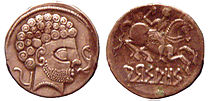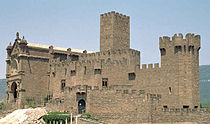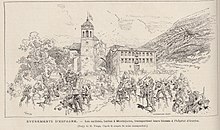Nafarroa Garaia
NavarreContext of Navarre
Navarre (English: ; Spanish: Navarra [naˈβara]; Basque: Nafarroa [nafaro.a]), officially the Chartered Community of Navarre (Spanish: Comunidad Foral de Navarra [komuniˈðað foˈɾal de naˈβara]; Basque: Nafarroako Foru Komunitatea [nafaro.ako foɾu komunitate.a]), is a landlocked foral autonomous community and province in northern Spain, bordering the Basque Autonomous Community, La Rioja, and Aragon in Spain and N...Read more
Navarre (English: ; Spanish: Navarra [naˈβara]; Basque: Nafarroa [nafaro.a]), officially the Chartered Community of Navarre (Spanish: Comunidad Foral de Navarra [komuniˈðað foˈɾal de naˈβara]; Basque: Nafarroako Foru Komunitatea [nafaro.ako foɾu komunitate.a]), is a landlocked foral autonomous community and province in northern Spain, bordering the Basque Autonomous Community, La Rioja, and Aragon in Spain and Nouvelle-Aquitaine in France. The capital city is Pamplona (Basque: Iruña). The present-day province makes up the majority of the territory of the medieval Kingdom of Navarre, a long-standing Pyrenean kingdom that occupied lands on both sides of the western Pyrenees, with its northernmost part, Lower Navarre, located in the southwest corner of France.
Navarre is in the transition zone between Green Spain and semi-arid interior areas, and thus its landscapes vary widely across the region. Being in a transition zone also produces a highly variable climate, with summers that are a mix of cooler spells and heat waves, and winters that are mild for the latitude. Navarre is one of the historic Basque districts: its Basque features are conspicuous in the north, but virtually absent on the southern fringes. The best-known event in Navarre is the annual festival of San Fermín held in Pamplona in July.
More about Navarre
- Native name Nafarroa Garaia
- Population 661537
- Area 10391
 Coins of Arsaos, Navarre, 150 – 100 BC, showing Rome's stylistic influence
Coins of Arsaos, Navarre, 150 – 100 BC, showing Rome's stylistic influence Read moreRead less
Read moreRead less Coins of Arsaos, Navarre, 150 – 100 BC, showing Rome's stylistic influenceAntiquity
Coins of Arsaos, Navarre, 150 – 100 BC, showing Rome's stylistic influenceAntiquity Castle of Xabier
Castle of XabierBefore and during the Roman Empire, the Vascones populated the southern slopes of the Pyrenees, including the area which would ultimately become Navarre. In the mountainous north, the Vascones escaped large-scale Roman settlement, except for some coastal areas—for example Oiasso (in what is now Gipuzkoa)—and the flatter areas to the south, Calagurris (in what is now La Rioja), which were amenable to large-scale Roman farming—vineyards, olives, and wheat crops. There is no evidence of battles fought or general hostility between Romans and Basques, as they had the same enemies.[1]
Neither the Visigoths nor the Franks ever completely subjugated the area. The Vascones (to become the Basques) assimilated neighbouring tribes as of the 7th century AD. In the year 778, the Basques defeated a Frankish army at the Battle of Roncevaux Pass.
Following the Battle of Roncevaux Pass (824), the Basque chieftain Iñigo Arista was elected King of Pamplona supported by the muwallad Banu Qasi of Tudela, establishing a Basque kingdom that was later called Navarre.[2] That kingdom reached its zenith during the reign of Sancho III, comprising most of the Christian realms to the south of the Pyrenees, and even a short overlordship of Gascony (in the early 11th century).[3]
When Sancho III died in 1035, the kingdom was divided between his sons.[4] It never fully recovered its political power, while its commercial importance increased as traders and pilgrims (the Francs) poured into the kingdom via the Way of Saint James.[5] In 1200, Navarre lost the key western Basque districts to Alphonse VIII of Castile, leaving the kingdom landlocked.[6] Navarre then contributed with a small but symbolic force of 200 knights to the decisive Battle of Las Navas de Tolosa in 1212 against the Almohads.
The native line of kings came to an end in 1234; their heirs intermarried with French dynasties.[7] However, the Navarrese kept most of their strong laws and institutions. The death of Queen Blanche I (1441) inaugurated a civil war period between the Beaumont and Agramont confederacies with the intervention of the Castilian-Aragonese House of Trastámara in Navarre's internal affairs.[8] In 1512, Navarre was invaded by Ferdinand the Catholic's troops,[9] with Queen Catherine and King John III withdrawing to the north of the Pyrenees, and establishing a Kingdom of Navarre-Béarn, led by Queen Joan III as of 1555.
To the south of the Pyrenees, Navarre was annexed to the Crown of Castile in 1515, but kept a separate ambiguous status, and a shaky balance up to 1610—King Henry III ready to march over Spanish Navarre. A Chartered Government was established (the Diputación), and the kingdom managed to keep home rule. Tensions with the Spanish government came to a head as of 1794, when Spanish premier Manuel Godoy attempted to suppress Navarrese and Basque self-government altogether, with the end of the First Carlist War (1839 – 1841) definitely bringing the kingdom and its home rule (fueros) to an end.[10]
Province of Spain Carlists in retreat to the Irache monastery during the Third Carlist WarMemorial to the Charters of Navarre erected by popular subscription in Pamplona, after the Gamazada (1903)
Carlists in retreat to the Irache monastery during the Third Carlist WarMemorial to the Charters of Navarre erected by popular subscription in Pamplona, after the Gamazada (1903) Arturo Campión (1854 – 1937), a major Basque Navarrese activist, and MP in Madrid during the GamazadaLoss of home ruleFaçade of the Parliament of Navarre in Pamplona
Arturo Campión (1854 – 1937), a major Basque Navarrese activist, and MP in Madrid during the GamazadaLoss of home ruleFaçade of the Parliament of Navarre in PamplonaAfter the 1839 Convention of Bergara, a reduced version of home rule (fueros) was passed in 1839. However, the 1841 Act for the Modification of Fueros (later called the "Compromise Act", Ley Paccionada) definitely made the kingdom into a province after a compromise was reached by the Spanish government with officials of the Provincial Council of Navarre. The relocation of customs from the Ebro river to the Pyrenees in 1841 prompted the collapse of Navarre's customary cross-Pyrenean trade and the rise of smuggling.
Amid instability in Spain, Carlists took over in Navarre and the rest of the Basque provinces. An actual Basque state was established during the Third Carlist War with Estella as its capital (1872 – 1876), but King Alfonso XII's restoration in the throne of Spain and a counter-attack prompted the Carlist defeat. The end of the Third Carlist War saw a renewed wave of Spanish centralisation directly affecting Navarre.
In 1893 – 1894 the Gamazada popular uprising took place centred in Pamplona against Madrid's governmental decisions breaching the 1841 chartered provisions. Except for a small faction (the so-called Alfonsinos), all parties in Navarre agreed on the need for a new political framework based on home rule within the Laurak Bat, the Basque districts in Spain. Among these, the Carlists stood out, who politically dominated the province, and resented an increased string of rulings and laws passed by Madrid, as well as left leaning influences. Unlike Biscay or Gipuzkoa, Navarre did not develop manufacturing during this period, remaining a basically rural economy.
Republic and military uprisingIn 1932, a Basque Country's separate statute failed to take off over disagreements on the centrality of Catholicism, a scene of political radicalisation ensued dividing the leftist and rightist forces during the 2nd Spanish Republic (1931 – 1939). Thousands of landless labourers occupied properties of wealthy landowners in October 1933, leaving the latter eager for revenge.[11] The most reactionary and clerical Carlists came to prominence, ideologues such as Víctor Pradera, and an understanding with General Mola paved the way to the Spanish Nationalist uprising in Pamplona (18 July 1936).
The triumphant military revolt was followed by a terror campaign in the rearguard against blacklisted individuals considered to be progressive ("reds"), mildly republican, or just inconvenient.[12] The purge especially affected southern Navarre along the Ebro banks, and counted on the active complicity of the clergy, who adopted the fascist salute and even involved in murderous tasks.[13][14] The killing took a death toll of at least 2,857, plus a further 305 dying in prisons (ill-treatment, malnutrition).[15]
The dead were buried in mass graves or discarded into chasms abounding on the central hilly areas (Urbasa, etc.). Basque nationalists were also chased to a lesser extent, e.g. Fortunato Aguirre, a Basque nationalist and mayor of Estella (and co-founder of Osasuna Football Club), was executed in September 1936. Humiliation and silence ensued for the survivors. Pamplona became the rebel launching point against the Republic during the War in the North.
Post-war sceneAs a reward for its support in the Spanish Civil War (Navarre sided for the most part with the military uprising), Franco allowed Navarre, as it happened with Álava, to maintain during his dictatorship a number of prerogatives reminiscent of the ancient Navarrese liberties.[16] The bleak post-war years were shaken by shortage, famine, and smuggling, with the economy relying on agriculture (wheat, vineyards, olive, barley), and a negative migration balance. The victors came to cluster around two main factions, Carlists and Falangists,[17] while the totalitarian ultra-Catholic environment provided fertile grounds for another religious group, the Opus Dei, to found their University of Navarre (1952), ever more influential in Pamplona.
The coming of the society of consumption and incipient economic liberalisation saw also the establishment of factories and workshops during the early 1960s (automobile manufacturing and accessories, etc.), especially around the overgrown capital. It was followed by labour and political unrest. In the run-up to Spanish democracy (Constitution ratified in 1978), Navarre plunged into a climate of violence practised by ETA, state-sponsored paramilitary groups and police forces, extending through the 1980s and beyond.
Tension during the Spanish transitionOfficials and figures with good connections to the Navarrese regional government went on to join Adolfo Suárez’s UCD, later splitting into the party UPN led by Jesús Aizpún Tuero (1979), refusing to join a democratic constitutional process on the grounds that Navarre’s charters (or fueros) remained in place. They also refused to join the Basque process to become an autonomous community, where recently legalised Basque nationalist and leftist parties held a majority.
A continuation of the institutional framework inherited from the dictatorship and its accommodation into the Spanish democracy was guaranteed by the Betterment (“Amejoramiento”), a Navarre-only solution considered ‘an upgrade’ of its former status issued from the (remains of the) charters. In a three-year span, the Spanish Socialists in Navarre veered in their position, quit the Basque process, and joined the arrangement adopted for Navarre (Chartered Community of Navarre, 1982). The reform was not ratified by referendum, as demanded by Basque nationalist and minority leftist forces.
^ "HISTORY OF THE BASQUE COUNTRY - THE ROMANS". Kondaira.net. ^ Collins, Roger (1990). The Basques (2nd ed.). Oxford, UK: Basil Blackwell. ISBN 0631175652., p. 140-141. ^ Collins (1990), p. 181. ^ Kennedy, Hugh (2014). Muslim Spain and Portugal: A Political History of Al-Andalus. Routledge. p. 150. ISBN 978-1317870418. ^ Collins (1990), pp. 214–215. ^ Collins (1990), pp. 185. ^ Collins (1990), pp. 232. ^ Monreal/Jimeno (2012), pp. 10–15. ^ Monreal, Gregorio; Jimeno, Roldan (2012). Conquista e Incorporación de Navarra a Castilla. Pamplona-Iruña: Pamiela. ISBN 978-84-7681-736-0., pp. 30 – 32 ^ Collins (1990), p. 275. ^ Paul Preston (2013). The Spanish Holocaust: Inquisition and Extermination in Twentieth-Century Spain. London, UK: HarperCollins. p. 182. ISBN 978-0-00-638695-7. ^ Preston, P. 2013, p. 179-181 ^ Preston, P. 2013, p. 182-184 ^ Charla con Lucio Urtubia [Talks with Lucio Urtubia] (in Spanish). CGT/LKN Bizkaia. 2014-04-15. Event occurs at 07’02. Archived from the original on 2021-11-02. Retrieved 2015-05-01. (First-hand witness Lucio Urtubia's testimony in Spanish) For the first time ever that is being talked about now, I only bore witness to crimes and abuses in my land carried out by that Church that if it really wanted, all could have been prevented. In the Ribera of Navarre, there are about 4,000 dead by fire-squad, people who had done no harm, no evil to anyone, they were just workers, farmers, the hunger-stricken, so that is why, because they were Republicans, or just affiliated to the CNT or UGT that they were executed by firearm. That was with the complicity of the Catholic Church, that is why I don't believe in that Church, that Church was horrific. That Church had the likes of don Pablo or don Vitoriano, who came down every morning, there were little kids who had just come from shooting in executions, with the former asking to them, "How many, how many today?", the kids going, "Three or four", in turn responding, "Small number, small number". I lived through all that. ^ Preston, P. 2013, p. 183 ^ "Navarra. Historia: Franquismo". Auñamendi Eusko Entziklopedia. EuskoMedia Fundazioa. Retrieved 16 September 2014. ^ "Navarra. Historia: Franquismo". Auñamendi Eusko Entziklopedia. EuskoMedia Fundazioa. Retrieved 16 September 2014.
- Stay safe








































